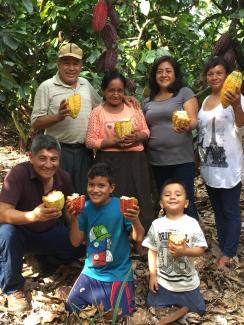Rolando Herrera didn’t set out to become a coca farmer.
It all started in the 1980s, when he was 18. A classmate proposed that he travel from Lima, Peru, to Tocache, a province in the Peruvian Amazon known for its fruits. He intended to find work and save enough money to finish his studies at the university.
After two years of working in a little store, the owner recommended that he become a coca farmer. At first, it didn’t seem to him to be such a bad way to make a living. Herrera earned good money from it, and coca production was a common income-generating activity in his village. In fact, in many Tocache villages at that time, coca production was the only way that most people could earn money.
Then, the situation turned dangerous. “In the 1990s, life got difficult. We lived in insecurity because of the disputes among drug traffickers, terrorists and military,” he remembers.
Trying to avoid the violence surrounding the coca-growing industry, Herrera decided to stop planting coca and work legally.
He first tried his hand at planting papaya and tobacco, but those crops failed. Worried, Herrera sought help, attended a USAID-supported workshop in 1996 to learn how to plant cacao trees, and started to cultivate 2 hectares of cacao.
His family and friends warned that cacao production would not reap profits for the first three years of the trees’ growth. “What are we going to eat during those three years?” they asked repeatedly.
Pressure came from other avenues, too. “Drug traffickers pressured me to not plant cacao,” recalls Herrera.
Through it all, Herrera remained optimistic and determined. He supported his family by working for other farmers while he cared for his small plot of cacao. And thanks to USAID, he learned techniques to improve cacao cultivation, which helped him to make his crops thrive.
Once his cacao began thriving, Rolando needed to find buyers. He traveled to the city of Tingo Maria to seek help from the Cooperative Naranjillo, a regional group of cacao producers supported by USAID. Here, he could get better prices from cacao buyers.
Herrera didn’t forget his fellow farmers as he started to prosper. He convinced 500 cacao producers in his village to join the Cooperative Naranjillo, and he became the first delegate from Tocache, representing all the cacao producers in the province. In 2010, he was elected president of the cooperative.
Herrera’s fellow cacao producers elected him president of the Peruvian Association of Cocoa Producers (APPCACAO) in 2011. Unsure of his ability to represent such a large organization—30,000 farmers—Herrera turned to Loren Stoddard, then-leader of USAID’s Alternative Development Office, for guidance. “Loren told me ‘Accept [the appointment as president]. We will support you,’” Herrera recounts.
Stoddard was true to his word. USAID remained by Herrera’s side, helping him and other cacao producers.
Over time, USAID also helped APPCACAO to expand Peruvian production abroad; helped to grow Peruvian cacao’s reputation until it became recognized as Peru’s flagship product; and introduced the Day of Peruvian Cacao, an annual nationwide celebration of the crop that features cultural events and tastings.
When Herrera finished his term as president, he decided to make the transition from cacao producer to chocolate maker. It took two years to obtain international certificates, design a business plan, and create a brand. Herrera’s efforts were fruitful, and he accomplished his goal: He now produces high-quality chocolate.
Today, Herrera reviews his progress with a smile: “Our first production was 30,000 chocolate bars, and I could not do it without the help of many friends and USAID. Thanks to USAID, I could get ahead. They were there when we needed them, and I am very grateful to them.”
USAID’s Alternative Development program supports Peruvian farmers by giving communities the opportunity to participate in legal and sustainable livelihoods. In 2015, the program worked with more than 31,700 families and helped Peruvians sell $34 million in legal crops of cacao. USAID’s efforts help to ensure that communities of the Peruvian Amazon remain coca-free, bolstering the emerging chocolate and coffee industries and helping Peruvians to build a more secure and prosperous future.
LINKS
Follow @USAIDPeru, on Facebook, on Flickr

Noelia Gutierrez, USAID
